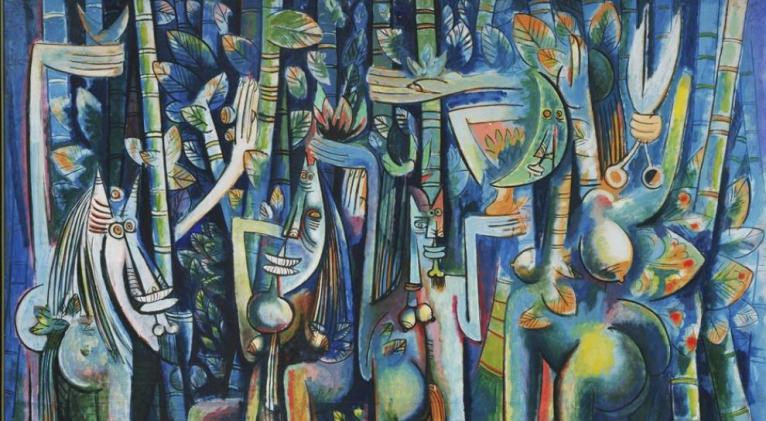Wilfredo Lam, the universality of Cuban identity and the artistic brilliance
especiales

Two significant anniversaries are to be celebrated in 2022 related to Cuban master of plastic arts Wilfredo Lam. Next December 8th, we will celebrate the 120th birthday anniversary in Sagua la Grande, Las Villas, while last September 11th, we remembered the 40th anniversary of his death, in 1982 in Paris, France.
Although Wilfredo Oscar de la Concepción Lam y Castilla -whose signature was Wifredo Lam- does not need the almanac to remind us that he is one of the greats, his fellow countrymen enjoy honoring him and thus enjoy many of his works exhibited with honor by the National Museum of Fine Arts, among other institutions.
His universal fame was gained especially as a painter, but he was also interested in ceramics, graphics, drawing and sculpture, genres in which his dedication was of high quality and in which he was able to show his restless spirit of innovation.
Avant-garde movements of his time, such as cubism and surrealism, regarded him as one of their practitioners or militants, depending on how you want to say it.
His greatest merit, according to his fellow countrymen and numerous experts, is having expressed, through his multifaceted and polysemic work, essential elements of his country identity and cosmogony. Having this, he made his way to universality and immortality.
Of course, all that mastery was linked to his immense talent and vast culture, but also marked by the knowledge acquired in early studies at the prestigious San Alejandro Cuban Academy of Fine Arts in Havana.
A year before his death, he was decorated with the Félix Varela Order, the nation's highest cultural award. Among his works stand out The King of Toys (1942), Hurricane (1944-1946), The Jungle (1943), whose original is exhibited in an important museum in New York; La Silla (1943), a jewel in the Fine Arts collection, Havana; and Seated Woman (1927).
Also infallible are Malembo, Canto a Camosis, Eternal Present, Escalopendre, Cardinal Harps, Luna Flower, Clay Light and Earth Rumor are also pieces of art work that cannot be ignored. There are outstanding exhibitions such as First Papers of Surrealism in New York, as well as in Paris, Prague, Milan and at the Institute of Modern Art in Chicago, just to name a few.
The presuppositions of his bold images used African and Chinese cultural elements for the first time. And there is certainly a plausible sociological explanation, in addition to the one referring to his academic training.
Of humble origins, he was the son of a Cantonese Chinese emigrant and a Creole woman in whom African and Spanish genes were mixed. This influenced the formation of his personality and then his professional performance. The features of his family were a vivid sign of the forging of national identity in a mixed-race country.
Today, when many of his works are exhibited in select museums and galleries in Europe, America and other continents, Martí's statement "Homeland is humanity" becomes true more than ever.
His biographers say that Lam’s artistic inclination was precocious, showing from childhood a preference for drawing and painting, something of which the Museum of History of his native Sagua la Grande keeps samples, like a treasure.
After completing three courses in San Alejandro (1920-1923) he traveled to Spain to study painting at the Academy of San Fernando in Madrid, paid by the City Council of Sagua la Grande.
He toured nearly the entire Iberian Peninsula, and although amazed by the academic and landscapes portraits, he was finally seduced by the paths of themes and techniques of modern art.
Spain was revealing and raised his awareness politically and socially speaking. He joined the international artistic brigades, defended the Spanish Republic, and acquired a leftist political stance, which was later influenced by his friendship with Pablo Picasso —with whom he immediately had an artistic and ideological communion— when he settled in Paris in 1938.
His links with surrealism and in general with Parisian bohemia opened the doors of a new world for him. In the Musée de l'Homme in Paris, he found invaluable samples of African art and sculpture, of great influence on his work from then on.
He began to create, in an accelerated evolution, with a sober style and economy of compositional resources. That formal composition announced him as a follower of Cubism.
He painted fruitfully in those years and many of Lam’s works from that time are today part of private collections all over the world.
During World War II, he is imprisoned for 40 days in Martinique along with other avant-garde intellectuals and artists, during a trip that had left Marseille.
He returns to Cuba in 1941. Settled in Havana, he also lived decisive moments for his career.
He seemed to put aside the European-Western pictorial influence in Havana, at least in terms of form, and he created hybrid representations that no one had ever seen in that world.
There was the universe of childhood traditions and experiences, even with his dreamlike and spiritual depth. Those elements nurtured the new creativity. They went hand in hand with family memories, the resounding island landscape, the sum of themes and icons of magical-religious systems of African origin, extended in the Caribbean and in Cuba. His own life.
The Jungle, defined as "the first plastic manifesto of the Third World" and La Silla, are considered essential reflections not only of his art, but also of a thought that without really abandoning European surrealism and cubism, captures and expresses all spirituality and humanity of the syncretic cults of Cuba and the entire Caribbean.
In 1951, he won the first prize of the National Hall, Havana. But he was a free spirit as most of the people of his kind, and in 1952 he returned to Europe. He not only works and creates tirelessly, always venturing into different techniques such as collage and lithography, painting of altars..., but also expands the connections that multiplied the resonance of a work of the highest value throughout the world.
He died in Paris, we do not know if "Thursday and with a downpour" as a great poet once wished for himself, together with the beautiful family that this brilliant, universal Cuban had built.
Translated by Sergio A. Paneque Díaz / CubaSí Translation Staff














Add new comment